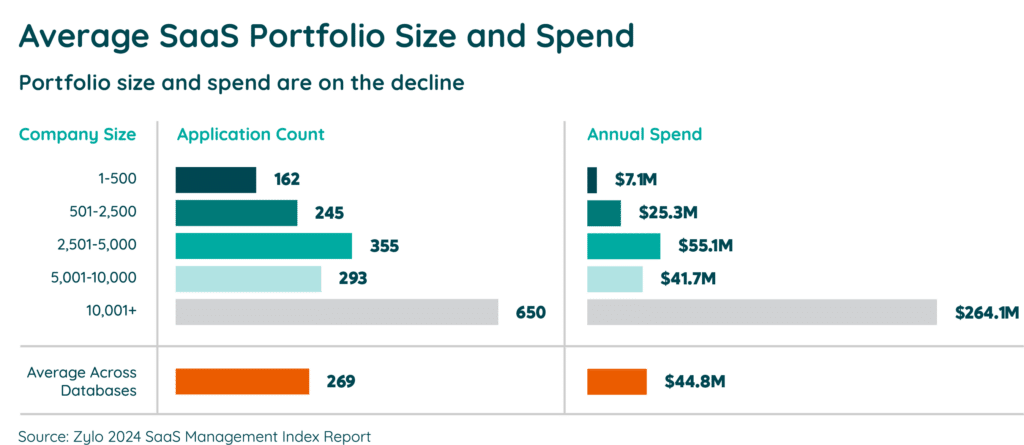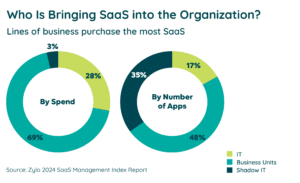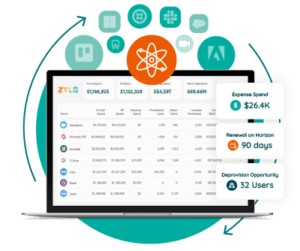How to Create an Effective Application Portfolio Management Strategy (that Includes SaaS)
To effectively manage software assets and maximize those investments across the business, enterprises employ application portfolio management (APM). APM simply means a proactive approach an organization uses to manage its software application assets. While traditionally thought of in the context of on-premise software, modern portfolio management must take SaaS into account.
APM becomes more complicated when you consider the dynamic nature of SaaS. According to Zylo research:
- Enterprises see 10 new applications enter their environment every 30 days.
- On average, nearly one in ten (7%) employees expenses SaaS.
- Enterprises spend an average of $264M a year on SaaS.
Learn the value of an APM strategy, and what an effective application portfolio management program should encompass when it comes to SaaS.

Why an Application Portfolio Management Strategy Matters
The ease of SaaS acquisition leads to decentralized purchasing. In fact, IT now only manages 28% of application spending. In contrast, business units and employees now manage 72% of SaaS spending.

This decentralization results in shadow IT—applications operating within an organization without proper oversight. This reduced visibility makes it hard to control costs and ensure security and compliance. With SaaS now the second-largest OpEx line item (next to headcount), a programmatic management approach proves more critical than ever.
In addition, effective APM empowers employees with the right tools, streamlines SaaS stacks, reduces cost, and maximizes investments. According to Gartner’s Market Guide for Application Portfolio Management Tools , the top use cases for APM include:
- Application rationalization and modernization : Gain visibility into current apps and eliminate any duplicate, redundant, and non-business critical tools.
- Business strategy alignment : Ensure apps help the business reach its goals.
- Application portfolio fitness monitoring : Conduct regular checks and balances to reduce SaaS bloat and ensure tools meet modern business requirements.
- Application risk, compliance, security, and privacy : Ensure regulatory compliance and safety from data breach and loss.
- IT cost optimization : Keep costs in line by rightsizing, and tracking and preparing for renewals .
- Cloud migration readiness and planning : Scrutinize IT infrastructure to assess and enhance cloud readiness.
Creating an APM Strategy
The first step to building an APM strategy is to consider your business goals and how APM can support them. For example, do you want to reduce operating expenses by consolidating your organization’s SaaS stack? Would you like your employees to self-select tools from a pre-vetted list of options? Do you want to enhance collaboration across departments by getting employees to use the same tools?
Next, understand that visibility into all applications used within the organization is necessary to implement an application portfolio management strategy. That means reining in shadow IT and utilizing a discovery tool to find SaaS wherever it lurks.
How the Zylo Discovery Engine Powers the Most Comprehensive SaaS Management Platform
Complete visibility uncovers the opportunities for improvement, which you can then prioritize according to your goals. Those opportunities include:
- Multi-channel spend : This occurs when you have an official agreement with the vendor, but users within the company still expense the tool individually. Finding multi-channel spend provides an opportunity to consolidate all existing licenses into your company plan. The new number of licenses may even garner a volume discount.
- Shadow IT : Within shadow IT, you’ll likely find multi-channel spend, duplicate apps, redundant apps, and many cases of overpaying or under-utilization—all of which provide opportunities to rationalize, rightsize, or eliminate apps.
- Low or no adoption or utilization : Dig into utilization data to see if there are any unused apps or licenses floating around. You can save money by either eliminating an unused app or deprovisioning employees no longer using a tool, then reassigning their licenses.
- Multiple cost centers : Look for the same recurring spend across multiple cost centers. This helps you find widely used apps that are ripe for negotiating enterprise agreements with the vendor.
- Cost avoidance : Proactive APM means always-on monitoring of app utilization and new apps entering the environment, aiding cost avoidance.
- Data-driven renewals : Keep track of renewal dates and usage data such as user sentiment, growth expectations, and price benchmarking to negotiate better deals and drive renewal cost savings .
Executing Your Strategy
Determining business needs and priorities allows you to create an ongoing application portfolio management strategy. Then, it’s time to put it into action. If reducing SaaS spend is your goal, those action steps may look like:
- Canceling apps with low or no utilization
- Instilling regular license reclamation for cost avoidance
- Using benchmarking data to negotiate better pricing at renewal
- Rightsizing licenses at renewal based on evaluated needs of your organization
- Implementing governance and purchasing policies to crack down on expensed software
- Consolidating multi-channel and departmental purchases into a single contract
With a goal of improving the utility of your organization’s SaaS stack, you should consider:
- Consolidating duplicative apps to reduce overall app count
- Canceling apps with low or no utilization to reduce overall app count
- Soliciting user feedback on applications to understand sentiment
- Setting software standards, offered through an employee app catalog
Powering Your Application Portfolio Management Strategy
To implement an effective APM strategy, you need complete visibility into your SaaS stack and utilization data that only a SaaS Management Platform can offer. Sure, you can try tracking apps and renewals in a spreadsheet, but that method results in errors, shadow IT, and wasted spend.

Companies that are serious about their APM strategies turn to Zylo for a SaaS Management Platform that offers:
- Comprehensive visibility : Zylo’s Discovery Engine powers comprehensive discovery, continual monitoring, and full optimization of SaaS applications to support holistic SaaS Management.
- Insights to action : Zylo Insights surfaces personalized, prioritized, and actionable recommendations to drive rightsizing and savings initiatives. Zylo’s App Overview brings spend, usage, and adoption insights together in a single view, so you can find everything you need to make confident decisions around your SaaS licenses and renewals.
- Automation : Save time with Zylo’s automated workflows, which allow you to act upon the Zylo Insights surfaced. For example, set a utilization threshold of 60 days. Then, if a user doesn’t use an app within 60 days, Zylo will proactively surface the insight, allowing you to instantly deprovision or downgrade the license.
In addition, Zylo allows you to deploy user sentiment surveys with a single click, and those surveys offer valuable insights to drive app adoption, renewal, or sunsetting decisions.
For more on using application portfolio management to track, monitor, and optimize your SaaS, check out this guide.




